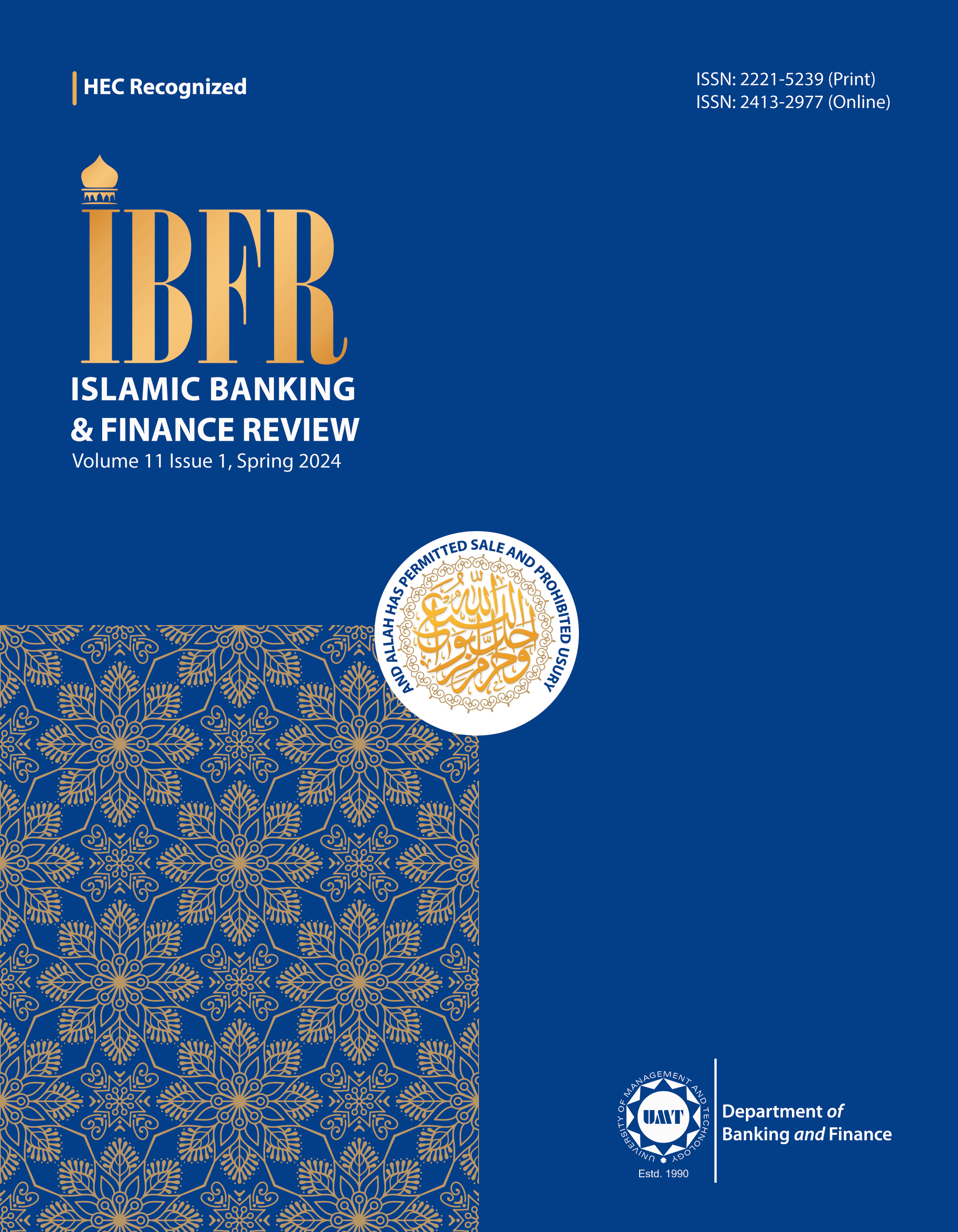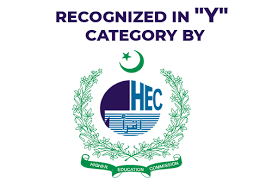Short-Term and Long-Term Analyses of Islamic House Financing by Islamic Banks of Pakistan
Abstract
 Abstract Views: 0
Abstract Views: 0
Islamic banks provide house financing in accordance with Islamic principles. There has been an increase in the popularity of Islamic house financing in Pakistan over the past few years. In this regard, the current study attempts to examine both short-term and long-term relationships between the variables associated with Islamic house financing. Several variables contribute to Islamic house financing. The current research incorporated four (4) variables, namely deposits, liabilities, Gross Domestic Product (GDP), and government expenditures. The macroeconomic variables included GDP and government expenditures, while the microeconomic variables included deposits and liabilities. The study also examines the causal effects of the variables on Islamic house financing in Pakistan. Additional information was collected from Meezan Bank through documentation review and measurements. Data was collected over the period 2018-2022. The Autoregressive Distributed Lag (ARDL) test and Granger causality test were the two econometric methods used to analyze time series data. It was determined that both macroeconomic factors and microeconomic factors play a significant role in Islamic house finance. Thus, with the help of this study, Islamic banks in Pakistan would be able to offer and expand Islamic house finance in the future.
Downloads
References
Adeboye, A. (2009). An Investigation into factors affecting housing finance supply in emerging economies: a case study of Nigeria. University of Wolverhampton.
Aliyu, S., Yusof, R. M., & Naiimi, N. (2017). The role of moral transaction mode for sustainability of banking business: A proposed conceptual model for Islamic microfinance banks in Nigeria. International Journal of Social Economics, 44(12), 2238–2256. https://doi.org/10.1108/IJSE-07-2016-0205.
Alrawahdeh, S. T. A., & Zyadat, A. A. F. H. (2021). The role of the Islamic banks in increasing domestic saving funding economic development in jordan. WSEAS Transactions on Business and Economics, 18, 905–915. https://doi.org/10.37394/23207.2021.18.86.
Arafat, Q. Y., Rashid, A., & Jan, Q. W. (2021). Impact of COVID-19 on the Performance and Stability of Conventional and Islamic Banks in the GCC Region, Malaysia, and Pakistan. Islamic Banking and Finance Review, 8(1), 24–37. https://doi.org/10.32350/ibfr.81.02.
Athanasoglou, P. P., Brissimis, S. N., & Delis, M. D. (2008). Bank-specific, industry- specific and macroeconomic determinants of bank profitability. Journal of International Financial Markets, Institutions and Money, 18(2), 121–136. https://doi.org/10.1016/j.intfin.2006.07.001.
Ayagre, P., Dzeha, G., Kriese, M., & Kusi, B. (2022). What drives bank lending? A closer look at bank lending types in Africa. African Journal of Economic and Management Studies, 13(2). https://doi.org/10.1108/AJEMS-08-2021-0352.
Ayoub, M., & Mifma, L. (2021). The effectiveness of Islamic finance for entrepreneurial business ( SMEs ) on the economic growth : The Malaysian experiment. Journal of Finance, Investment and Sustainable Development, 6(2), 477–493.
Deniz, B. (2022). Determinants of Bank Lending in Turkey. Middle East Technical University.
Fah, C., & Hassani, A. (2014). A Study of Islamic and Conventional Banks in Malaysia. Journal of King Abdulaziz University-Islamic Economics, 27(1). https://doi.org/10.4197/Islec.27-1.3.
Gani, I. M. (2019). An Analysis of Islamic Financial Activities and Economic Growth Relationship: Another Evidence from Malaysia. Proceeding of the 14th ISDEV International Islamic Development Management Conference.
Gani, I. M., & Bahari, Z. (2021). Islamic banking’s contribution to the Malaysian real economy. ISRA International Journal of Islamic Finance, 13(1), 6–25. https://doi.org/10.1108/ijif-01-2019-0004.
Hachicha, N., & Ben Amar, A. (2015). Does Islamic bank financing contribute to economic growth? The Malaysian case. International Journal of Islamic and Middle Eastern Finance and Management, 8(3). https://doi.org/10.1108/IMEFM-07-2014-0063.
Hussain, G., Hafeez, M., & Batool, H. (2021). Islamic Modes of Finance and Economic Growth: A Mediating Role of Financial Stability in Case of Islamic Countries. Elementary Education Online, 20(5), 5298–5307. https://doi.org/10.17051/ilkonline.2021.05.593.
Ibrahim, M. H., & Rizvi, S. A. R. (2018). Bank lending, deposits and risk-taking in times of crisis: A panel analysis of Islamic and conventional banks. Emerging Markets Review, 35, 31–47. https://doi.org/10.1016/j.ememar.2017.12.003.22.
Iqbal, M. S., & Fikri, S. M. (2023). Comparison of Credit Risk Management Practices among Islamic and Public Commercial Bank’s in Pakistan. International Journal of Management Research and Emerging Sciences, 13(3).
Iqbal, M. S., & Fikri, S. M. (2023). The Determinants of Growth in Banking Sector: Time Series Analysis of Conventional And Islamic Banking In Pakistan. Islamic Banking and Finance Review, 10(1), 51-67. https://doi.org/10.32350/ibfr.101.03.
Iqbal, M. S., & Sofi, M. F. B. (2022). Analyzing the impact of oil prices on commodity future listed on Pakistan mercantile exchange (PMEX) in the era of Covid-19. South Asian Review of Business and Administrative Studies (SABAS), 4(2), 103-112.
Ma’in, M., Tajuddin, N. A., & Nathan, S. B. S. (2016). Household Debt and Macroeconomic Variables in Malaysia. 121–130. https://doi.org/10.15405/epsbs.2016.11.02.12.
McKinnon, R. I. (1973). Money and Capital in Economic Development. The Brookings Institution.
Md Isa, M. A., Latif, R. A., Zaharum, Z., Nasrul, F., & Noh, M. K. A. (2019). Internal Factors Influencing Commercial Banks Lending Behaviour in Malaysia. Advanced International Journal of Banking, Accounting and Finance, 1(1), 48–58. https://doi.org/10.35631/aijbaf.11005.
Mohd Yusof, R., Usman, F. H., Mahfudz, A. A., & Arif, A. S. (2018). Macroeconomic shocks, fragility and home financing in Malaysia: can rental index be the answer? Journal of Islamic Accounting and Business Research, 9(1), 17–44. https://doi.org/10.1108/JIABR-11-2015-0058,
Mozumder, P., & Marathe, A. (2007). Causality relationship between electricity consumption and GDP in Bangladesh. Energy Policy, 35(1), 395–402. https://doi.org/10.1016/j.enpol.2005.11.033.
Nizar, N., & Karim, Z. A. (2021). The relationship between household credit and banking stability in Malaysia: Panel evidence. Gadjah Mada International Journal of Business, 23(2), 155–172. https://doi.org/10.22146/gamaijb.64451.
Pesaran, M. H., Shin, Y., & Smith, R. J. (2001). Bounds testing approaches to the analysis of level relationships. Journal of Applied Econometrics, 16(3), 289– 326. https://doi.org/10.1002/jae.616.
Pesaran, M. H., Shin, Y., & Smith, R. P. (1999). Pooled Mean Group Estimation of Dynamic Heterogeneous Panels. Journal of the American Statistical Association, 94(446), 621–634. https://doi.org/10.1080/01621459.1999.10474156.
Rahman, N. A. A., Kosim, Z., & Siew, G. Y. (2018). The Characteristics of Household Loans in Conventional and Islamic Banks in Malaysia. International Journal of Academic Research in Business and Social Sciences, 8(7), 531–541.
Samad, K. A., Daud, S. N. M., & Rusmita, S. A. (2022). Household Debt and Economic Growth: The Role of Institutional Quality. Pertanika Journal of Social Sciences and Humanities, 30(3), 977–1001. https://doi.org/10.47836/pjssh.30.3.03.
Shukor, N. B. M., Said, R., & Majid, R. A. (2016). The Relationship between Housing Finance and Macroeconomics Variables in Malaysia. MATEC Web of Conferences, 66, 00100. https://doi.org/10.1051/matecconf/20166600100.
Wei, T. K., & Said, R. (2021). Non-Performing Property Loans and Its Origination in the Real Estate Finance System: Case Study of Malaysia. International Journal of Property Sciences, 11(1), 35–59. https://doi.org/10.22452/ijps.vol11no1.3.
Yee, C. P. (2022). THE ROLE OF MALAYSIA ECONOMIC GROWTH AND LOCAL ISLAMIC BANK. 26(1), 131–140.
Yusof, R. M., Kassim, S. H., Majid, M. S. A., & Hamid, Z. (2011). Determining the viability of rental price to benchmark Islamic home financing products: Evidence from Malaysia. Benchmarking, 18(1). https://doi.org/10.1108/14635771111109823.
Zulkhibri, M. (2018). The impact of monetary policy on Islamic bank financing: bank- level evidence from Malaysia. Journal of Economics, Finance and Administrative Science, 23(46), 306–322. https://doi.org/10.1108/JEFAS-01-2018-0011NA
Copyright (c) 2024 Muhammad Saeed Iqbal

This work is licensed under a Creative Commons Attribution 4.0 International License.
Authors retain copyright and grant the journal right of first publication with the work simultaneously licensed under a Creative Commons Attribution (CC-BY) 4.0 License that allows others to share the work with an acknowledgement of the work’s authorship and initial publication in this journal.












